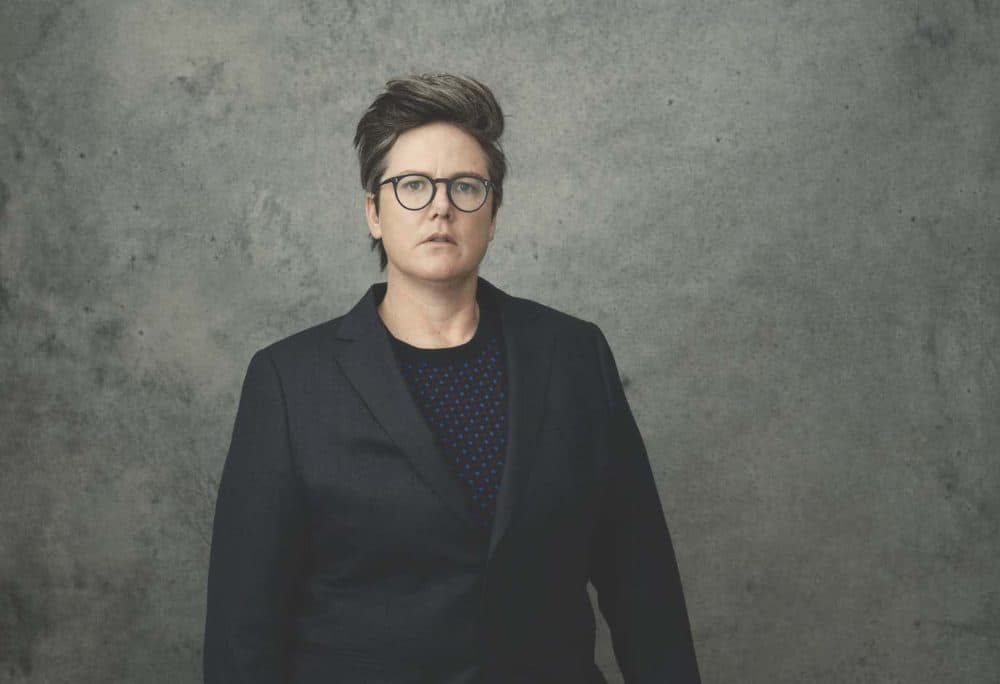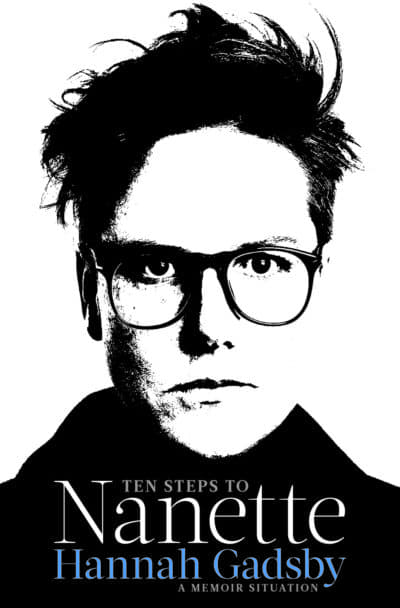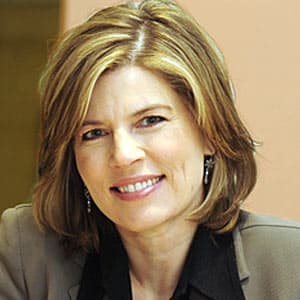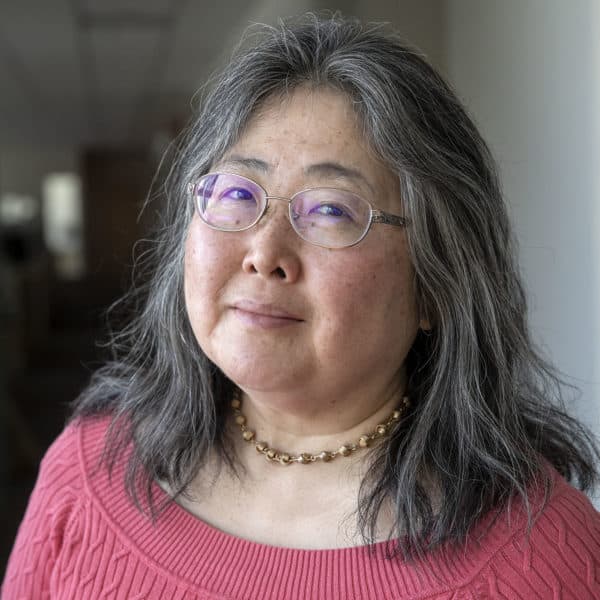Advertisement
Comedian Hannah Gadsby opens up about autism diagnosis, sexuality in memoir 'Ten Steps to Nanette'
Resume
In 2017, stand-up comedian Hannah Gadsby electrified audiences in her native Australia, the UK, and the United States with her performance piece "Nanette."
Now, Gadsby has published the memoir "Ten Steps to Nanette: A Memoir Situation" about everything that led up to her personal, honest performance. Gadsby went through a “grueling experience” as “Nanette” rose in popularity, she says.
“The show kept getting bigger and bigger beyond my intentions of writing it, more and more shows and bigger shows outside of my comfort zone,” she says. “I felt like my life wasn't mine to control for a while.”
As someone with autism, Gadsby struggles to describe her brand of comedy because she doesn’t understand how people see her so she approaches her craft with brutal honesty.
In the book, Gadsby gets candid about how she received an autism diagnosis later in life — much to her relief. Without a diagnosis, she says she lacked a framework to understand how her brain works.

“When you know that you're different but you don't understand why, it's really confusing and it's really destabilizing,” she says. “And it often leads to a lifetime of making mistakes that you don't know how to fix.”
Getting a diagnosis helped Gadsby understand her behavior and better protect herself from stressful situations, she says.
The memoir chronicles the difficulties Gadsby faced in high school, college and her early 20s. She started pursuing stand-up comedy after she entered her first competition and won. Comedy saved her life, she writes.
Participating in “the bureaucracy of life” is difficult for someone like Gadsby, she says. But in comedy, her differences serve as a gift and give her the confidence to pursue her career.
“It's hard for me to know what I would have done had I not found comedy,” she says. “I don't have a brain that flourishes under most circumstances that the world has built to be important.”
Interview Highlights
On what prompted Gadsby to write “Ten Steps to Nanette”
“I was writing this book before I wrote ‘Nanette,’ and originally I was going to write a collection of essays about being accident-prone, which is still true. But during the course of trying to write a book and making sense of my life, every time I sent something back to editors, they'd say ‘This part of your life doesn't make sense.’ So I kept having to go back and as I was digging deeper into my life, my parallel life on stage, I just sort of kept getting pushed to this place where I felt like ‘Nanette’ had to be written. So in a way, the book pushed me to write ‘Nanette’ and then ‘Nanette’ pushed me to finish the book.”
On how the diagnosis of autism and ADHD changed the way she thinks about comedy
“I stopped trying to solve myself for the audience's benefit. I was always trying to relate my idiosyncratic life and idiosyncratic way of being and tried to mask that and tried to be who people would assume I would be. And it felt like I was pushing through sludge. Once I was diagnosed, I understood better the way that my mind worked, and that elevated my thinking about myself in a way that I could then adapt my communication to things that I wanted to talk about instead of trying to explain my deficiencies.”
On why she pivoted away from self-deprecating humor
“I believe that the way you talk about yourself informs the way you think about yourself. I didn't make that up. I think that's well-known wisdom. So it made sense to me that I should shift the way that I talk about myself in my most public forum, which was my job. Or else I would be relegating myself to a life of not thinking very much of myself. I was being literally paid to demean myself.”
On growing up in Tasmania, where homosexuality was criminalized until 1997
“The laws were written, but they only pertained to gay men. Lesbians were pretty much an invisible situation. So it was that sort of, on one hand, understanding that you were existing in a criminal humanity, but also invisible. I lived through a time where they were deliberately trying to harvest ignorance around an identity that was also on the same hand around the world trying to show visible pride, which was what the ‘90s sort of was in gay culture. And we're seeing something very similar now with trans identity. And the 'Don't Say Gay' bills in Florida, which is it's frightening to think that this is now happening. It very much echoes what was happening to me as a child. And it just forces one to internalize the hatred of themselves to such a deep level that it's difficult to pick yourself out of it.”
On her experiences with homophobic and sexual violence
“I don't try to dwell on the specifics of the traumas. In my show I’m very much of the opinion that you learn from the part of the story you focus on. So I try and focus on what happens after, the pain and suffering that happens after and that you need community, you need other people. You need help to get yourself out of trauma. I believe too often the onus is on the individual to heal themselves, and I just honestly don't think that's possible. I think you need support networks, you need external scaffolding and you need help to undo trauma.”
On the quote from her book, “There's nothing stronger than a broken woman who has rebuilt herself,” and how she managed to rebuild
“When you recover from these things and you're from an unsupported place, that is incredible strength. To get to the point where I could perform 'Nanette' meant that I was stronger than most of my peers because of the amount of abuse and stuff that I endured. Any kind of little heckle I could get was just small fries. I just think that the more that you've been through, the stronger you are. But I don't feel like that's a badge of honor. I think that's a shame. We shouldn't have to do that alone.”
On what kind of comedy she’s doing now
“I do whatever comedy I like. When I write a show, I think about what I want the audience to feel. When I wrote 'Nanette,' I wanted the audience to feel something akin to a punch in the guts, you know, metaphorical, of course. With this show. I'm trying to make a warmer show. It's a hug. That's how I'm phrasing it. I wanted people to feel held and in a safe place and a reprieve. And, you know, because I feel like life is a battle everywhere now for all sorts of different reasons. And I wanted to create a sort of a community hug in the room.”
Book excerpt: 'Ten Steps to Nanette'
By Hannah Gadsby
Technically, this is my second book. But I wouldn’t bother trying to find a copy of my first effort as it was only published in an edition of one, and I’ve misplaced it. This is no great loss to literature because my first book was a very bad book. Although, I shouldn’t be too hard on myself, the story does have a bit of charm considering I was only seven years old when I penned it. But as a stand-alone piece of writing, it is terrible. Even the title is bad:
How Siffin Soffon became friendly with a Dragon. Part One
I put a spoiler in the title. What a fool. Why would you bother reading a book when you already know that no matter how dramatic the narrative twists and turns might be, Siffin Soffon and the Dragon will eventually end up on pretty good terms.
Clearly, I had an epic series in mind when I added “Part One” to the title, but sadly I never got round to writing the second instalment. Even so, one would assume I’d have left the reader with a cliffhanger so as to whet their appetite for Part Two, but no, Part One ends with Siffin Soffon and his new dragon pal waving a happy goodbye from the pleasant shores of “Holiday Island.” No wonder I never got round to writing the sequel, I couldn’t even think of a name for an island beyond the singular purpose I’d invented the island for. I was clearly all out of ideas.
I suppose you might want to read the book just to find out who this Siffin Soffon character is, but here, again, you’ll find my writing falls short because, apparently, I didn’t think it was necessary to offer a description of the central character of my novella. My accompany- ing drawings could have been enlightening, but again, ambiguity reigns; Siffin Soffon begins his epic journey as a carefully executed, albeit childishly rendered, little red goat, but by the time he becomes friendly with the Dragon he is just a lazy tangle of orange squiggles because I’d grown bored of drawing and had also, presumably, lost the red pencil. Fortunately, I do have some insider knowledge on this matter, and I can report that Siffin Soffon was neither a red goat nor an orange squiggle, he was the imaginary friend of my older brother, Hamish, and according to him, Siffin Soffon was a tiny foot-baller who lived in the toilet with his best friend Kinnowin.
When the one copy of my very bad book found its way back to me recently, I was inundated with a cluster of memories that I didn’t even know I had. I’m not talking about repressed memories, they didn’t return with a shocking jolt, they just quietly worked their way to the front of my thought queue as if they’d never left.
The cover, two pieces of red cardboard bound by masking tape, had faded and softened over time, but my poorly planned title still looked as if it had only been poorly executed just yesterday. As I held it in my hands, I recalled how angry seven-year-old me had become the moment I realised that I didn’t have enough space for the last six words of the title, and I felt the heat of my self-admonishment rise as sharp as if thirty-five years had not passed. Flipping through to the back page, I saw the note of praise written by the vice principal next to a reward sticker of the Pink Panther curving himself around a giant pen with the words “Well Done!” spilling from its point. I remembered how lovingly I’d traced around the sticker with my finger, almost bursting with pride. I also recalled that I had felt a little bit annoyed that it was only the vice principal, and how I’d wondered what the hell I had to do to get the principal’s attention. I could also remember how my teacher had insisted she write my story out for me because I was too young to have my pen licence and how she had then insisted that I read my story to the whole class, and how every- one in my whole class had HATED both me and my book. I don’t blame them. It was, after all, a very bad book.
The return of my literary debut stirred up memories that went well beyond the object itself, and included the emotional roller coaster that had precipitated my urge to put pen to paper. It had all begun with my obsession with Hamish’s imaginary friends and the mounting distress I felt because they didn’t want to be my friends too. I hadn’t known what “imaginary” meant and had just assumed that Hamish had cool friends who refused to talk to me, which made for many toilet-time tears. I also remembered how, after it was explained to me that Hamish’s friends lived inside his head, I had asked if I was allowed to imagine Siffin Soffon too, and when Hamish said no, I’d burst into tears again and this prompted Hamish to offer me the thoroughly unacceptable compromise of the imagined friendship of Kinnowin. I did not accept, because I only really wanted Sif- fin Soffon, who I’d imagined was a little red goat and had managed to convince myself that I could sometimes hear him clip-clopping on the plumbing. I did not care for Kinnowin, I hardly knew her, I didn’t even know what she looked like.
I also remembered how, at one point, I’d attempted to conjure my own imaginary friends and began galloping about on my horse, Sergeant, while chatting to my good friend Mr. Dog, who was a dog I’d obviously named in the tradition of Holiday Island. It was not a winning moment, as I could only recall how profoundly foolish I had felt because I knew my friends were not real, and, to make matters worse, I had imagined them to be incredibly large chaps, which meant I still didn’t have any friends to talk to in the toilet. I don’t know what to call my next move, as I don’t think it is possible to kill beings that do not exist, so let’s just say that I ghosted Sergeant and Mr. Dog, violently. It felt humane at the time, but really, I just wanted them out of the way so I could try my luck with Siffin Soffon again. After my needless imaginary horse-and-dog ritual sacrifice, Hamish told me I was too late. His friends were gone. When I pressed him for their whereabouts, he very sombrely reported that they were in Heaven helping God. Throughout my childhood and well into adulthood I worshipped Hamish and it often felt, painfully so, that he deliberately abused the power that he had over me. But when I remember episodes like this, I know that simply couldn’t be true of a small boy who not only assumed that God would need the help of tiny football players but who also felt such levels of loneliness that he had to invent friends he could talk to, and poo on. He clearly had issues of his own.
Excerpted from Ten Steps to Nanette: A Memoir Situation by Hannah Gadsby. Copyright © 2022 by Hannah Gadsby. Excerpted by permission of Ballantine Books, an imprint of Penguin Random House LLC. All rights reserved. No part of this excerpt may be reproduced or reprinted without permission in writing from the publisher.
This segment aired on March 29, 2022.

